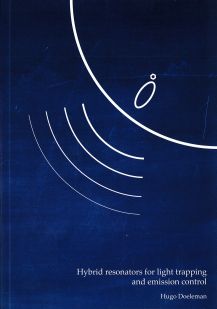Hybrid resonators for light trapping and emission control
Light is at the heart of many present-day technologies. Control over the interaction strength between light and matter is pivotal to the success of most such technologies. Such control is typically offered by optical resonators, which store and confine light to increase its interaction strength with matter. Yet, today, the most commonly used resonators suffer from intrinsic drawbacks that limit their implementation on a large scale, particularly in a network for quantum information processing.
This thesis studies how hybrid resonators, which support states for light that are composed of multiple underlying states, can overcome the limitations of single resonators and provide new ways to guide and store light. In particular, we consider two types of hybrid resonators – hybrids composed of an optical cavity and a plasmonic antenna, and bound states in the continuum.
In the context of antenna-cavity hybrids, we theoretically explore the mechanism of interaction between an antenna and a cavity, and how this influences the ability of the hybrid to store and confine light. Experimentally, we study light scattering and fluorescence in these systems, which we fabricate using a novel fabrication method.
We furthermore present an experimental study of a recently discovered optical resonance – a bound states in the continuum. We discuss how this state can arise from hybridization of two resonances, and reveal experimentally a topologically protected polarization vortex associated with this state.
Overall, this thesis shows the great potential – and limitations – of hybrid resonators for control over the flow and confinement of light.



